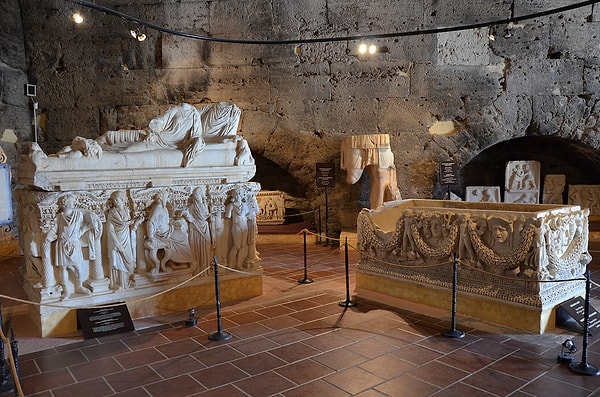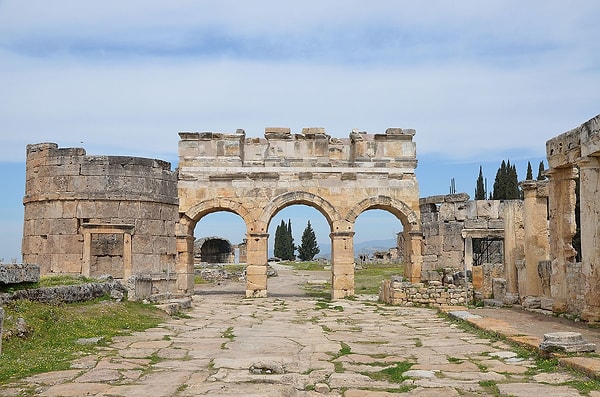Explore Hierapolis Ancient City: A Journey Through History in Turkey
The ancient city of Hierapolis, situated in the Pamukkale district of Denizli, is not just an archaeological site; it is a place where time stands still, its history intertwined with mythology, Roman monuments, and a cultural texture that is enriched by thermal waters and magnificent structures. A UNESCO World Heritage Site, this ancient city is a unique destination for history lovers and nature enthusiasts alike.
In this guide, we cover every aspect of Hierapolis in detail, from its historical origins to its ancient theatre, from its sacred pool to its museum. You will also find transportation tips, places to visit, and useful information to help plan your visit.
History of Hierapolis: Earthquakes that gave birth to a Sacred City

The foundation of Hierapolis dates back to the 2nd century BC, during the Pergamon Kingdom. Founded by Eumenes II, the city was probably named after the Amazon queen Hiera. The name of the city means ‘Hierapolis’ in Greek, meaning ‘Holy City’. This title indicates both mythological connotations and the religious activities in the region for many years.
Hierapolis prospered especially during the Roman Empire and became a centre of health and faith. The healing effect of the thermal waters made it one of the most popular treatment centres of antiquity. However, this fertile city has been subjected to many destructive earthquakes throughout history and has been rebuilt each time.
Mythological and Religious Importance

One of the most remarkable aspects of Hierapolis is its mythological and religious past. In ancient times, the city was home to a sacred cave called ‘Ploutonion’ dedicated to Pluton, the god of the underworld. It is thought that the poisonous gases emanating from this cave were used in ritual sacrifices to the god.
Hierapolis, which is also of great importance for Christianity, is commemorated with the crucifixion of St. Philip the Apostle here. The octagonal monumental tomb and chapel built in the name of St. Philip and dated to the 5th century can still be visited today.
Must-See Places in Hierapolis

The ancient city of Hierapolis is a very rich architectural and artistic area. Among the structures that visitors should not miss, the following stand out:
Ancient Theatre:
The theatre, one of the most impressive structures of Hierapolis, has a capacity of 12,000 people and attracts attention with its marble stage building and detailed reliefs. This building, which carries all the splendour of Roman architecture, also hosts concerts and events today.
Temple of Apollo:
This temple, built in the name of Apollo, the main god of the city, is connected to the Ploutonion sanctuary. The temple area was used for both religious ceremonies and divination activities.
Ploutonion (Hell Gate):
This cave, where thermal gases rise and is considered ‘deadly’, served as an altar to the gods in ancient times. Modern research has confirmed that the carbon dioxide gas emitted from this cave is fatal for living things.
Necropolis Area:
The necropolis, one of the largest areas of Hierapolis, provides important information about the death rituals of the ancient period with thousands of sarcophagi, tumuli and tomb structures. Since the city was a healing centre, many patients from the surrounding regions came here and lost their lives here.
Roman Baths and Latrina:
These structures, which were health and hygiene centres in ancient times, are also very valuable in terms of architecture. The Roman bath is now used as the Hierapolis Archaeological Museum.
Sacred Pool (Ancient Pool):
This thermal pool, which offers the opportunity to swim among the columns broken from the destroyed ancient buildings, combines both history and healing with its natural mineral water. Legends that Cleopatra swam here also add a special attraction to this place.
Hierapolis Archaeological Museum

The Hierapolis Archaeological Museum, established in the old Roman bath structure, exhibits sculptures, sarcophagi, architectural pieces and objects of daily life unearthed during the excavations of the ancient city. In addition, artefacts brought from surrounding ancient cities such as Laodicea, Tripolis and Colossae can also be seen here.
How to get to Hierapolis?

Hierapolis Ancient City is very easy to reach. It is approximately 18 kilometres from Denizli city centre and is located within the borders of Pamukkale Town. It can be reached in a short time by private car or Pamukkale minibuses departing from the city centre. There are also regular bus services from Denizli Bus Station to Pamukkale.
Visitors arriving by plane at Denizli Çardak Airport can reach Hierapolis by renting a car or by shuttle.
Entrance Fees and Visiting Hours
Entrance to Hierapolis and Pamukkale travertines is provided with a common ticket. The Museum Card is valid. There is also an extra charge for visitors who want to use the Ancient Pool. Visiting hours may vary according to the summer and winter seasons, so up-to-date information should be checked on the official website of the Ministry of Culture and Tourism.
Other Places to Visit in the Area

For visitors to Hierapolis, there are many areas worth seeing in the immediate vicinity. Pamukkale Travertines has become the symbol of the region and offers a natural visual feast with its unique white terraces. In addition, the ancient city of Laodicea, which is a short distance away, is one of the important trade centres of antiquity and must be seen.
For nature lovers, Karahayıt Hot Springs offers an interesting geothermal experience with its red coloured mineral waters. Alternative sightseeing spots such as Buldan, Honaz Mountain and Kaklık Cave can also be added to the route.
Source: Kültür Portalı
Keşfet ile ziyaret ettiğin tüm kategorileri tek akışta gör!

Send Comment